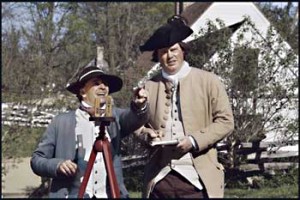Proprietors were akin to a modern corporation in that they owned a % of the land and acted as a board of directors for the town. The money they put in would have gone initially toward purchase of Lot #8. Further payments would have gone to legal costs, surveying and any remaining costs for Indian claims. Costs for meeting house and roads generally were shared among proprietors and settlers. Proprietors might or might not be settlers (see “New England Town Development”).
 Proprietors may have wanted to get cheap land and have been willing to commit to the hard work of clearing or may have been pure investors hoping to gain by the appreciation in land value to be expected as the land was cleared and roads were built. The first distribution of property was by lots with later distributions being settled based on the % each proprietor had put in. In the case of Lenox, several rounds of distribution seem to have taken place as soon as the surveying was completed. Lenox proprietors held an average of about two hundred acres.
Proprietors may have wanted to get cheap land and have been willing to commit to the hard work of clearing or may have been pure investors hoping to gain by the appreciation in land value to be expected as the land was cleared and roads were built. The first distribution of property was by lots with later distributions being settled based on the % each proprietor had put in. In the case of Lenox, several rounds of distribution seem to have taken place as soon as the surveying was completed. Lenox proprietors held an average of about two hundred acres.
Our information on these important early investors is frustratingly sketchy.
The George Tucker manuscript lists (from documents now at the Berkshire County Middle Registry of Deeds) the proprietors below. If other sources* listed other information about the proprietor it is added here to give some flavor of the people involved. It is clear from the limited facts available that the investors who were not planning to settle, quickly monetized their holdings. In a non-money economy such as Colonial Berkshire County, and land changed hands numerous times from town founding to 1775 and seems to have provided cash for other uses, settlement of debt, etc.

Daniel Allen
Moses Ashley
Jacob Bacon – Dismissed from committee to build meeting house for failing to do anything
Issac Brown
Jonathan Bull
Christopher Cartwright
Samuel Churchill
Titus Curtis**
Israel Dewey** – Elected to Highway Committee, Meeting House Committee; the Deweys must have been major investors in Lenox, holding a half dozen of the original lots. There are 12 Deweys buried at Church on the Hill
Israel Dewey, Jr.
Solomon Glezen – Elected to Highway Committee; dismissed from original committee to build meeting house, elected to new one; in 1771, on behalf of the town of Lenox, Israel Dewey, Eliza Willard and Amos Stanley rented Lot# 6 (School House Lot – just north of the current location of the Church on the Hill) to him for use by the town; in 1772, 100 acres of the lot was sold to Jonathan Foster of Lenox with continued yearly rent by the town of “one peppercorn.”
Charles Goodrich – dismissed from committee to build meeting house for failing to do anything
Samuel Goodrich**
Eleanor Gunn – The only female listed as a proprietor, Eleanor (the former Eleanor Ingersoll) appears to have been the widow of Capt. Stephen Gunn who died at the age of 39 in 1759 of small pox in Great Barrington. Typical of other settlers of south Berkshire County, Capt. Gunn had been born in Westfield. Given the date and his title, his death may have been related to the last French and Indian War. The Registry of Deed records show “Gunn” on two lots near the Pittsfield line but descriptive information suggests Oliver Partridge (who along with other Ingersolls had an abutting lot) and or the ubiquitous Sam Brown of Stockbridge forced the widow to sign over her land in payment of a debt. Mention is made of “having found no goods in Widow Gunn’s house.”
Jonathan Hough
John Ingersoll
Daniel Jones
Elijah Jones
Josiah Jones, Jr.
Josiah Jones
Joseph Lee
Edward Martindale
Elisha Martindale – Elected to Committee to Build Meeting House and Committee to procure preacher; the Martindales were also holders of a large number of initial lots but there are no Martingales listed among the Church on the Hill burials.
Gershom Martindale** – elected to Highway Committee
Stephen Nash-dismissed from committee to build meeting house for failing to do anything; one of the Stephen Nash’s had participated in purchasing 1/2 of lot #6 (which was to be used for the school) from Sam Brown Jr. in 1764. It looks like Sam Brown may have purchased the same property from Josiah Jones in 1763. Of course the price was higher each time the property changed hands!
Stephen Nash, Jr.
Moses Nash
Asa Noble
David Pixley
David Pixley, Jr.
Abraham Root
Abel Rowe
Ashbel Treat
Timothy Treat
Ezra Whittlesey
Earlier settlers (such as Jonathan Hinsdale) may have already been resident on the land (whether proprietor or grant land) and may have rented or made arrangements to purchase after the initial lot selection.
*George Tucker Manuscript, Berkshire County Middle Registry of Deeds, Church on the Hill 1906 Centennial History, East Street Book
**Signers of the 1774 Non Importation Agreement